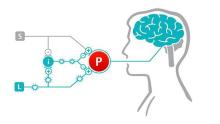Pain Perception, Distraction/Engagement, and Biofeedback
O.J. Sahler, MD
Outline:
- What is Pain?
- What is Anxiety?
- Why Distraction/Engagement Works
- What is Biofeedback?
What is pain?
Unpleasant feeling — sensory or emotional — often caused by intense or damaging stimuli
What does a person do in response to pain?
- Withdraws from the damaging stimuli
- Protects a damaged body part while it heals
- Avoids similar experiences in the future
What is anxiety?
- Unpleasant state of inner turmoil with nervous or clinging behavior
- Physical changes include palpitations, tachycardia, hyperventilation, muscle tension, headache, stomach ache
- Being anxious that pain will escalate can become a self-fulfilling prophecy
How sensory input is transmitted to the brain
| Type of Nerve Fiber | Information Carried | Conduction Speed (mi/hr) |
|---|---|---|
| Painful Stimuli | ||
| C | Pain (sharp, burning) | 2 mi/hr leisurely walk |
| A-delta | Pain (cold, pressure) | 60 mi/hr highway driving |
| Non-Painful Stimuli | ||
| A-alpha | Awareness of the environment | 200 mi/hr airplane taking off |
Gate Theory

Why Distraction/Engagement Works:
- "It's All in Your Head"
- "Take Your Mind Off Your Pain"
What is distraction?
- Something that diverts attention and makes it hard to think or do work
- Something that amuses or entertains and makes it hard to think about problems (e.g., pain)
What is engagement?
- Emotional, cognitive, and behavioral connection that exists between a user and a resource
Nerve Fiber Bandwidth

Only a certain amount of information can be carried to the brain at a given time. If most of the afferent nerve fibers are carrying information about the environment (engaged with TV or friends, reading, playing video games), the amount of information about pain that reaches the brain is subthreshold and, therefore not perceived.
Good Medicine
- Being able to be distracted by or engaged with someone or in something is good medicine
- Being able to distract/engage yourself is the best medicine
What is biofeedback?
- Measuring a person's quantifiable physiologic functioning (e.g., heart rate, blood pressure, skin temperature)
- Conveying that information to the person in real time
- Raises the person's awareness and conscious control over seemingly unconscious (automatic) physiologic activities
Access to Information
Providing access to physiologic information that was previously considered an automatic response allows the person to gain control of the response and modify it.
Biofeedback for Stress
Biofeedback is particularly useful in controlling/decreasing the stress response by helping a person understand how he/she can superimpose the relaxation response using mind/body self-regulation techniques.
Circulatory changes in the stress and relaxation responses
Stress:
- Increased blood flow to vital organs (brain, heart, lungs) and the muscles of "fight or flight"
- Decreased blood flow to non-vital areas (small muscles of the hands and feet)
Relaxation:
- Homeostatic circulation
Biofeedback is probably efficacious for:
- Alcoholism/substance abuse
- Arthritis
- Chronic pain
- Epilepsy
- Fecal elimination disorders
- Insomnia
- Traumatic brain injury
Biofeedback is efficacious for:
- Anxiety
- ADHD
- Hypertension
- Migraine, cluster headaches, tension headaches
Biofeedback is efficacious and specific for:
- Urinary incontinence in females through perineal muscle strengthening
Replace Biofeedback with Relaxation Training?
Some believe using biofeedback to manage stress and anxiety could be replaced by simple relaxation training, meditation, and self-hypnosis.
Biofeedback is Relaxation Training
In fact, biofeedback is only the use of an external monitor while practicing relaxation (using any method desired) so the person can see how effective his/her relaxation techniques are and learn how to strengthen them.
Biofeedback Benefits
"When people see that they can produce physiological changes [through] relaxation, this has both motivational and cognitive effects... building a sense of self efficacy and confidence that their actions will lead to benefits."
Reference
Powers SW et al JAMA 2012; 310: 2622-30.

